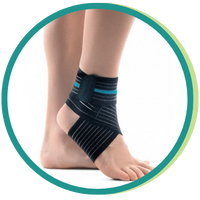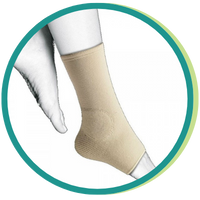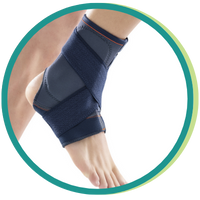
How to treat a sprained ankle?
One misstep is enough to lead to an ankle sprain – one of the most common musculoskeletal injuries. This injury, which occurs regardless of age or physical activity, happens when one or more ligaments in the ankle are stretched or torn, causing pain, swelling, and difficulty walking.
You should never ignore a sprain and hope that the symptoms eventually pass without seeking medical attention, especially if it causes severe pain and swelling. Without proper treatment and rehabilitation, a more severe sprain may not heal well and lead to loss of motion and balance, or even more frequent sprains.
In this article, we will explore in more detail what an ankle sprain is, how you can treat it, and in which cases you should use compression socks in your treatment.
Important: This article should not be interpreted as medical advice. Please contact a doctor for a proper diagnosis of your specific case.
WHAT IS A SPRAINED ANKLE?
The ankle is made up of three bones: the tibia, fibula and talus. These bones are held together by ligaments – structures formed by fibrous tissue (mainly collagen) that provide support to the ankle. When you twist your ankle, these ligaments can become stretched or torn. In the case of severe sprains, you may even hear a “pop” at the time of injury.
A sprain can range in severity from mild to severe, depending on the extent of the ligament damage. A mild sprain may cause some swelling and discomfort, but it does not make it impossible to walk. A severe sprain, on the other hand, can cause swelling and more serious complications.
Symptoms of an ankle sprain can include swelling, bruising, pain, stiffness, and difficulty sustaining body weight on the injured ankle. If you suspect that you have sprained your ankle, it is important to seek medical attention. A doctor can determine the severity of the injury and recommend the best treatment.
Immediately after an ankle sprain, you should assess the degree of the injury to understand what treatment is most appropriate. As a general rule, you can use the table below as a reference.
| Severity | Ligament damage | Symptoms | Recovery time |
| Grade 1 | Minimal stretching, no breakage. | Mild pain, swelling and tenderness. Usually no bruising. No joint instability. No difficulty in bearing weight. | 1-3 weeks |
| Grade 2 | Partial stretching. | Moderate pain, swelling and tenderness. Possible injury. Mild to moderate joint instability. Some loss of flexibility. Pain when bearing weight and walking. | 3-6 weeks |
| Grade 3 | Total stretching or rupture. | Severe pain, swelling, tenderness, and bruising. Considerable instability, with loss of motion. Inability to bear weight or walk. | Months |
HOW TO TREAT A SPRAINED ANKLE?
Important: You should always consult your doctor to ensure the most appropriate treatment for a sprained ankle, especially if you are unsure about the degree of injury or if symptoms persist for several days.
Treatment of an ankle sprain depends on the severity of your injury. The goals of treatment are to reduce pain and swelling, promote ligament recovery, and restore ankle function. For severe injuries, you may be referred to a specialist in musculoskeletal injuries, such as an orthopedic surgeon.
For a grade 1 (mild) sprain, you should follow these steps:
- Rest the ankle, without walking on it. Limit your efforts as much as possible and use crutches if necessary. If you have no fracture, you can support some weight on your leg. One ankle stabilizer can help control swelling and provide more stability while the ligaments are healing.
- Apply ice to reduce swelling. Do not put the ice directly on the skin (use a thin cloth between the ice pack and the skin) and do it in 20-minute intervals.
- Compression helps stop swelling. You can apply some compression to the ankle with an elastic bandage until the swelling stops, but be careful not to over-tighten the ankle as this may hamper circulation. Consider also the use of compression stockings These are much easier to use than elastic bandages. Its gradual compression also prevents over-compression of an injury.
- To reduce swelling, raise your ankle above the level of your heart, especially at night. Gravity helps to reduce swelling by draining excess fluid.
- If you are experiencing significant pain, consider taking anti-inflammatory medications such as ibuprofen, which can help reduce pain and swelling. Be sure to follow the instructions on the label and consult a doctor if you are unsure which medication to take.
If you follow these steps, the swelling should go away within a few days.
For a grade 2 (moderate) sprain, follow the previous guidelines and keep the treatment going longer. Consult your doctor to find out if you should immobilize your ankle.
A grade 3 (severe) sprain puts you at risk of permanent ankle instability. On occasion, surgery may be necessary, especially in competitive athletes. For severe ankle sprains, your doctor may also consider applying a cast for 2-3 weeks. If you have frequent sprains, you may need ligament surgery. Always consult your doctor.
SHOULD I WEAR COMPRESSION STOCKINGS TO TREAT A SPRAINED ANKLE?
The compression stockings provide gentle pressure on the ankle and foot. This pressure helps reduce swelling and improve circulation, which can speed up the recovery process from a sprain.
One of the main benefits of compression stockings is to help prevent swelling in the feet and ankles. This is especially useful for people who are on their feet for long periods of time, such as nurses, doctors, and other health care professionals.
As we saw earlier, compression is one of the most important factors in the treatment of ankle sprains. Thus, the use of compression stockings may be beneficial in this treatment.
If you have a history of ankle sprains, it is recommended that you wear compression ankle sleeves before participating in physical activities, because you are more likely to have another sprain. These compression sleeves help prevent further injury as they improve performance and balance during physical activity and improve recovery time.
Note that while compression sleeves and stockings help with pain and swelling relief, they do not cure the injuries.

Elastic Ankle Support With Band
Although they are one of the most common muscle injuries, ankle sprains should not be ignored.
You should always consult your doctor to ensure specialized treatment, especially in the event of severe pain or difficulty in movement. As we have seen in this article, milder sprains can usually be treated with a combination of rest, ice, elevation and compression.
Compression stockings can be very helpful in the correct application of compression, both during the treatment of a sprain and in preventing sprains during more demanding physical activities.
At Loja Ortopédica’s online store, we have a wide selection of compression stockings that may help in the treatment of ankle sprains. Consult your doctor for advice on the right way to treat your injury. If you need assistance in choosing compression stockings contact us !
Our specialized technical team is ready to answer your questions. You can contact us at 244 233 085 or send us an e-mail to apoiocliente@lojaortopedica.pt .
Loja Ortopédica ® – We know and have what you need!







No Comments